.gif)
Veronica (plant)
Encyclopedia

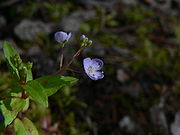
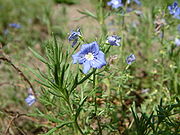




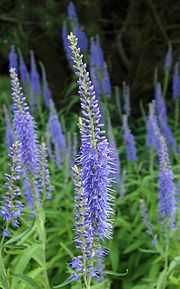

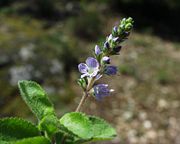
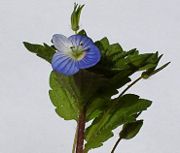

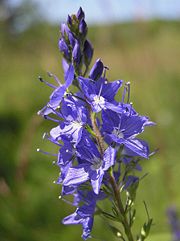

Flowering plant
The flowering plants , also known as Angiospermae or Magnoliophyta, are the most diverse group of land plants. Angiosperms are seed-producing plants like the gymnosperms and can be distinguished from the gymnosperms by a series of synapomorphies...
family Plantaginaceae
Plantaginaceae
Plantaginaceae Juss. or plantain family, are a family of flowering plants in the order Lamiales. The type genus is Plantago L..In older classifications it used to be the only family of the order Plantaginales, but numerous phylogenetic studies, summarized by the Angiosperm Phylogeny Group, have...
, with about 500 species; it was formerly classified in the family Scrophulariaceae
Scrophulariaceae
Scrophulariaceae, the figwort family, are a family of flowering plants. The plants are annual or perennial herbs with flowers with bilateral or rarely radial symmetry. Members of the Scrophulariaceae have a cosmopolitan distribution, with the majority found in temperate areas, including...
. Taxonomy for this genus is currently being reanalysed, with the genus Hebe
Hebe (plant)
Hebe is a genus of plants native to New Zealand, Rapa in French Polynesia, the Falkland Islands, and South America. It includes about 90 species and is the largest plant genus in New Zealand. Apart from H. rapensis , all species occur in New Zealand. This includes the two species, H. salicifolia...
and the related Australasian genera Derwentia, Detzneria, Chionohebe, Heliohebe, Leonohebe and Parahebe included by many botanists. Common names include speedwell, bird's eye, and gypsyweed.
The species are herb
Herb
Except in botanical usage, an herb is "any plant with leaves, seeds, or flowers used for flavoring, food, medicine, or perfume" or "a part of such a plant as used in cooking"...
aceous annuals
Annual plant
An annual plant is a plant that usually germinates, flowers, and dies in a year or season. True annuals will only live longer than a year if they are prevented from setting seed...
or perennials
Perennial plant
A perennial plant or simply perennial is a plant that lives for more than two years. The term is often used to differentiate a plant from shorter lived annuals and biennials. The term is sometimes misused by commercial gardeners or horticulturalists to describe only herbaceous perennials...
, and also shrub
Shrub
A shrub or bush is distinguished from a tree by its multiple stems and shorter height, usually under 5–6 m tall. A large number of plants may become either shrubs or trees, depending on the growing conditions they experience...
s or small trees if Hebe is included. Most of the species are from the temperate Northern Hemisphere
Northern Hemisphere
The Northern Hemisphere is the half of a planet that is north of its equator—the word hemisphere literally means “half sphere”. It is also that half of the celestial sphere north of the celestial equator...
, though with some species from the Southern Hemisphere
Southern Hemisphere
The Southern Hemisphere is the part of Earth that lies south of the equator. The word hemisphere literally means 'half ball' or "half sphere"...
; Hebe is mostly from New Zealand
New Zealand
New Zealand is an island country in the south-western Pacific Ocean comprising two main landmasses and numerous smaller islands. The country is situated some east of Australia across the Tasman Sea, and roughly south of the Pacific island nations of New Caledonia, Fiji, and Tonga...
.
Species of Veronica are used as food plants by the larva
Larva
A larva is a distinct juvenile form many animals undergo before metamorphosis into adults. Animals with indirect development such as insects, amphibians, or cnidarians typically have a larval phase of their life cycle...
e of some species of Lepidoptera
Lepidoptera
Lepidoptera is a large order of insects that includes moths and butterflies . It is one of the most widespread and widely recognizable insect orders in the world, encompassing moths and the three superfamilies of butterflies, skipper butterflies, and moth-butterflies...
, including the Grizzled Skipper
Grizzled Skipper
The Grizzled Skipper Pyrgus malvae is a butterfly of the Hesperiidae family.-Appearance, behaviour and distribution:With its characteristic chequered black and white pattern this butterfly is quite distinctive although old, faded individuals can be mistaken for the Dingy Skipper or the Sideridis...
.
Uses and edibility
Veronica americanaVeronica americana
Veronica americana, variously called American Brooklime or American Speedwell, is a plant native to temperate and arctic Asia and North America where it grows in streams and bottomlands....
is edible and nutritious and is reported to have a flavor similar to watercress
Watercress
Watercresses are fast-growing, aquatic or semi-aquatic, perennial plants native from Europe to central Asia, and one of the oldest known leaf vegetables consumed by human beings...
. Native Americans used Veronica species as an expectorant tea to alleviate bronchial congestion associated with asthma and allergies. The plant can be confused with skullcap
Scutellaria
Scutellaria is a genus of flowering plants in the mint family, Lamiaceae. It contains about 300 species, which are commonly known as skullcaps...
and other members of the mint family. Members of the mint family have square sided stems, and Veronica species have rounded stems, and are easily distinguished from skullcap.
Weed
Several species of speedwell invade lawns. Some of the more common of these are Persian (veronica speedwell or birdseye speedwell), Creeping speedwell, Corn Speedwell (Veronica arvensis), Germander Speedwell (Veronica chamaedrys), and ivyleafspeedwell. It is often difficult to tell one species from another. A comparison photo of three of the common weed species is here. There are five-to-seven species of speedwell in Michigan alone that are easily confused.
The turf invading speedwell species have a fine, fibrous root system, bright green roundish, oval, or heart-shaped leaves with scalloped edges. The leaves are often tiny, with some being under 1/4 inch long, the flowers are typically very small and are blue or bluish-white in color. In all the weed species but one, the leaves are alternate near the end of (flowering)
stems, but the leaves are opposite near the base.
Because most varieties are somewhat resistant to the selective herbicides such as 2,4-D amine and they all prefer thinning (and often shady or moist) turf, a recommended method of control to improve turf growing conditions. Having fine fibrous roots, they are not difficult to individually pull from wet soil, taking care to remove the entire stem and any branches. Pre-emergent herbicides are usually effective against the seeding, non-creeping annual varieties. If one can precisely identify the species of both weed and turf, often an effective selective combination or triple herbicide can be found. The common non-selective herbicides are also very effective, but kills lawns and turf.
Species
- Veronica abyssinica
Abyssinian Speedwell - Veronica acinifolia
French Speedwell - Veronica acipetala
- Veronica acrotheca
- Veronica adamsii
- Veronica agrestisVeronica agrestisVeronica agrestis or Green Field-speedwell is a plant belonging to the family Plantaginaceae....
Green Field-speedwell - Veronica alaskensis
- Veronica alatavica
- Veronica albicans
- Veronica albiflora
- Veronica allahuekberensis
- Veronica allionii
- Veronica alpina
Alpine Speedwell - Veronica americanaVeronica americanaVeronica americana, variously called American Brooklime or American Speedwell, is a plant native to temperate and arctic Asia and North America where it grows in streams and bottomlands....
American Brooklime - Veronica amoena
- Veronica amplexicaulis
- Veronica anagallis-aquaticaVeronica anagallis-aquaticaVeronica anagallis-aquatica is a species of flowering plant in the plantain family known by the common names water speedwell, blue speedwell, and brook pimpernel. Its true native range is not clear, but the plant is present on most continents, and in most places it is probably naturalized...
Water Speedwell - Veronica anagalloides
- Veronica angustissima
- Veronica annulata
- Veronica antalyensis
- Veronica aphylla
- Veronica aragonensis
- Veronica archboldii
- Veronica arcuata
- Veronica arenaria
- Veronica arganthera
- Veronica argute-serrata
- Veronica armena
Armenian Speedwell - Veronica armstrongii
- Veronica arvensisVeronica arvensisVeronica arvensis is a medicinal plant and noxious weed native to Africa, Asia and Europe ....
Wall Speedwell - Veronica aucheri
- Veronica austriaca
Austrian Speedwell - Veronica avromanica
- Veronica aznavourii
- Veronica bachofenii
- Veronica balansae
- Veronica baranetzkii
- Veronica barkeri
- Veronica barrelieri
- Veronica baumgartenii
- Veronica baylyi
- Veronica beccabunga
Brooklime - Veronica bellidioides
- Veronica benthamii
- Veronica besseya
- Veronica biggarii
- Veronica biloba
- Veronica birleyi
- Veronica bishopiana
- Veronica blakelyi
- Veronica bogosensis
- Veronica bollonsii
- Veronica bombycina
- Veronica borisovae
- Veronica bozakmanii
- Veronica brachysiphon
- Veronica brassii
- Veronica breviracemosa
- Veronica brevistyla
- Veronica brownii
- Veronica buchananii
- Veronica bucharica
- Veronica bullii
- Veronica bungei
- Veronica cachemirica
- Veronica caespitosa
- Veronica calcicola
- Veronica californica
- Veronica calycina
Cup Speedwell - Veronica campylopoda
- Veronica cana
- Veronica canbyi
- Veronica canterburiensis
- Veronica capillipes
- Veronica capitata
- Veronica cardiocarpa
- Veronica carminea
- Veronica carstensensis
- Veronica catarractae
- Veronica catenata
- Veronica caucasica
Caucasian Speedwell - Veronica ceratocarpa
- Veronica cetikiana
- Veronica chamaedryoides
Greek Germander Speedwell - Veronica chamaedrysVeronica chamaedrysVeronica chamaedrys is a species of Veronica, native to Europe and northern Asia. It is found on other continents as an introduced species. It is a herbaceous perennial plant with hairy stems and leaves. It can grow to 25 cm tall, but is normally about 12 cm tall. The flowers are blue,...
Germander Speedwell - Veronica chamaepithyoides
- Veronica chathamica
- Veronica chayuensis
- Veronica cheesemanii
- Veronica chinoalpina
- Veronica chionantha
- Veronica ciliata
- Veronica ciliolata
- Veronica cinerea
- Veronica cockayneana
- Veronica colensoi
- Veronica colostylis
- Veronica continua
- Veronica copelandiiVeronica copelandiiVeronica copelandii is a rare species of flowering plant in the plantain family known by the common name Copeland's speedwell. It is endemic to California, where it is known only from the southeastern Klamath Mountains in Shasta and Trinity Counties. It occurs in mountain meadows and forest habitat...
- Veronica corriganii
- Veronica crinita
- Veronica crista-galli
Cock's-crest Speedwell - Veronica cryptomorpha
- Veronica cuneifolia
- Veronica cupressoides
- Veronica cusickiiVeronica cusickiiVeronica cusickii is a species of flowering plant in the plantain family known by the common name Cusick's speedwell. It is native to western North America from British Columbia to Montana to northern California, where it is occurs in mountain meadows and forests...
Cusick's Speedwell - Veronica cymbalaria
Pale Speedwell - Veronica czerniakowskiana
- Veronica dabneyi
Azores Speedwell - Veronica daghestanica
- Veronica daranica
- Veronica daurica
- Veronica davisii
- Veronica debilis
- Veronica decora
- Veronica decorosa
- Veronica decumbens
- Veronica deltigera
- Veronica densiflora
- Veronica derwentianaVeronica derwentianaVeronica derwentiana is a flowering plant species of the family Plantaginaceae, endemic to south-eastern Australia. It is sometimes included in the genus Parahebe or Derwentia. It is a woody herb which grows to 140 cm high. Leaves are 5 to 20 cm long, with a cuneate, truncate or cordate...
- Veronica dichrus
- Veronica dieffenbachii
- Veronica dilatata
- Veronica dillenii
- Veronica diosmifolia
- Veronica diosmoides
- Veronica dissecta
- Veronica distans
- Veronica donii
- Veronica elliptica
- Veronica elmaliensis
- Veronica emodii
- Veronica epacridea
- Veronica erinoides
- Veronica eriogyne
- Veronica euphrasiifolia
- Veronica evenosa
- Veronica evexa
- Veronica fargesii
- Veronica farinosa
- Veronica fedtschenkoi
- Veronica ferganica
- Veronica filifolia
- Veronica filiformisVeronica filiformisVeronica filiformis is a species of flowering plant in the genus Veronica. It is known by many common names, including slender speedwell, creeping speedwell, threadstalk speedwell and Whetzel weed. It is native to eastern Europe and western Asia, and it is known in many other regions as an...
Slender Speedwell - Veronica filipes
- Veronica flavida
- Veronica formosa
- Veronica forrestii
- Veronica fragilis
- Veronica francispetae
- Veronica fridericae
- Veronica fruticans
Rock Speedwell - Veronica fruticulosa
- Veronica fuhsii
- Veronica galathica
- Veronica gaubae
- Veronica gentianoides
Gentian Speedwell - Veronica gibbsii
- Veronica glandulosa
- Veronica glauca
- Veronica glaucophylla
- Veronica gorbunovii
- Veronica gracilis
- Veronica grandiflora
- Veronica grisebachii
- Veronica grosseserrata
- Veronica gunae
- Veronica haastii
- Veronica hectorii
- Veronica hederifoliaVeronica hederifoliaVeronica hederifolia is a flowering plant belonging to the family Plantaginaceae. It is native to Eurasia and it is present in other places as an introduced species and a common weed. It is an annual herb growing from a taproot and producing a hairy, spreading stem up to about 60 centimeters long...
Ivy-leaved Speedwell - Veronica henryi
- Veronica hillebrandii
- Veronica himalensis
- Veronica hispidula
- Veronica hookeri
- Veronica hookeriana
- Veronica hulkeana
- Veronica idahoensis
- Veronica incana
Silver Speedwell - Veronica inflexa
- Veronica insularis
- Veronica intercedens
- Veronica ionantha
- Veronica jacquinii
Jacquin's Speedwell - Veronica japonensis
- Veronica javanica
- Veronica jovellanoides
- Veronica kaiseri
- Veronica kellowiae
- Veronica khorassanica
- Veronica kiusiana
- Veronica kopetdaghensis
- Veronica kopgecidiensis
- Veronica kotschyana
- Veronica krumovii
Bulgarian Germander Speedwell - Veronica krylovii
- Veronica kurdica
- Veronica laeta
- Veronica lanceolata
- Veronica lanosa
- Veronica lanuginosa
- Veronica lavaudiana
- Veronica laxa
- Veronica laxissima
- Veronica leiocarpa
- Veronica leiophylla
- Veronica lendenfeldii
- Veronica ligustrifolia
- Veronica lilliputiana
- Veronica linariifolia
Linear-leaved Speedwell - Veronica linifolia
- Veronica lithophila
- Veronica liwanensis
- Veronica longifoliaVeronica longifoliaVeronica longifolia syn. Pseudolysimachion longifolium is a flowering plant of the genus Veronica in the family Plantaginaceae.-References:...
Long-Leaved Speedwell - Veronica longipedicellata
- Veronica longipetiolata
- Veronica luetkeana
- Veronica lyalii
- Veronica lycica
Lycian Speedwell - Veronica lycopodioides
- Veronica lysimachioides
- Veronica macrantha
- Veronica macrocalyx
- Veronica macrocarpa
- Veronica macropoda
- Veronica macrostachya
- Veronica macrostemon
- Veronica macrostemonoides
- Veronica magentea
- Veronica magna
- Veronica mampodrensis
- Veronica masoniae
- Veronica mazanderanae
- Veronica mexicana
Mexican Speedwell - Veronica michauxii
- Veronica micrantha
- Veronica microcarpa
- Veronica minuta
- Veronica miqueliana
- Veronica mirabilis
- Veronica missurica
- Veronica monantha
- Veronica montana
Wood Speedwell - Veronica montbretii
- Veronica monticola
- Veronica mooreae
- Veronica morrisonicola
- Veronica multifida
- Veronica muratae
- Veronica murrellii
- Veronica myosotoides
- Veronica nakaiana
- Veronica nevadensis
- Veronica nevskii
- Veronica niicola
- Veronica nipponica
- Veronica nipponica
- Veronica niveaVeronica niveaVeronica nivea is a flowering plant species of the family Plantaginaceae, endemic to south-eastern Australia. It is sometimes included in the genus Parahebe or Derwentia....
- Veronica notabilis
- Veronica notialis
- Veronica novae-hollandiae
- Veronica nummularia
- Veronica nutans
American Alpine Speedwell - Veronica oblongifolia
- Veronica obtusata
- Veronica ochracea
- Veronica odora
- Veronica oetaea
- Veronica officinalisVeronica officinalisVeronica officinalis is a species of Veronica, native to Europe and western Asia....
Heath Speedwell - Veronica olgensis
- Veronica oligosperma
- Veronica oltensis
- Veronica oltensis
- Veronica onoei
- Veronica opaca
- Veronica orbelica
- Veronica orbiculata
- Veronica orchidea
- Veronica orientalis
- Veronica ornata
- Veronica orsiniana
- Veronica ovata
- Veronica oxycarpa
- Veronica paederotae
- Veronica panormitana
- Veronica papuana
- Veronica pareora
- Veronica parnkalliana
- Veronica parviflora
- Veronica pauciramosa
- Veronica paysonii
- Veronica pectinata
- Veronica peduncularisVeronica peduncularisVeronica peduncularis is a plant in the plantain family, Plantaginaceae.-Description:Veronica peduncularis is a herbaceous plant with alternate, simple leaves, on creeping stems. The flowers are blue, borne in spring....
- Veronica pentasepala
- Veronica perbella
- Veronica peregrinaVeronica peregrinaVeronica peregrina is a species of flowering plant in the plantain family known by several common names, including neckweed, American speedwell and purslane speedwell. It is native to the Americas, and it is known on other continents as an introduced species and a common weed...
American Speedwell
- Veronica perfoliataVeronica perfoliataVeronica perfoliata known as Digger's Speedwell is a small plant found in high altitude areas in south-eastern Australia. Attractive purple flowers form in summer....
Digger's Speedwell - Veronica persicaVeronica persicaVeronica persica is a flowering plant native of Eurasia. First recorded in Britain in 1825 and now widespread in the United States, and east Asia .-General description:The seed leaves are broadly triangular cotyledons, with truncated base...
Common Field-speedwell - Veronica petraea
- Veronica petriei
- Veronica phormiiphila
- Veronica pimeleoides
- Veronica pinguifolia
- Veronica pinnata
- Veronica piroliformis
- Veronica planopetiolata
- Veronica plantaginea
- Veronica platycarpa
- Veronica plebeia
- Veronica polifolia
- Veronica politaVeronica politaVeronica polita or Grey Field-speedwell is a plant species of the genus Veronica....
Grey Field Speedwell - Veronica polium
- Veronica poljensis
- Veronica ponae
- Veronica poppelwellii
- Veronica porphyriana
- Veronica praecox
Breckland Speedwell - Veronica propinqua
- Veronica prostrataVeronica prostrataVeronica prostrata or Sprawling Speedwell is a plant species of the genus Veronica....
Sprawling Speedwell - Veronica pubescens
- Veronica pusilla
- Veronica pyrethrina
- Veronica qingheensis
- Veronica quadrifaria
- Veronica quezelii
- Veronica rakaiensis
- Veronica ramosissima
- Veronica ranunculina
- Veronica raoulii
- Veronica rapensis
- Veronica rechingeri
- Veronica regina-nivalis
- Veronica reuteriana
- Veronica rhodopea
- Veronica riae
- Veronica rigidula
- Veronica ritteriana
- Veronica robusta
- Veronica rockii
- Veronica rosea
- Veronica rotunda
- Veronica rubra
- Veronica rubrifolia
- Veronica rupicola
- Veronica ruprechtii
- Veronica sachalinensis
- Veronica sajanensis
- Veronica salicifolia
- Veronica salicornioides
- Veronica samuelssonii
- Veronica sartoriana
- Veronica saturejoides
- Veronica saxosa
- Veronica scardica
- Veronica scheereri
- Veronica schistosa
- Veronica schizantha
- Veronica schmidtiana
- Veronica scopulorum
- Veronica scutellataVeronica scutellataVeronica scutellata is a species of flowering plant in the plantain family known by the common names marsh speedwell, grassleaf speedwell, and skullcap speedwell. It is native to northern North America, including most of Canada and the northern half of the United States. It occurs in moist and wet...
Marsh Speedwell - Veronica senex
- Veronica sennenii
- Veronica serpyllifoliaVeronica serpyllifoliaVeronica serpyllifolia is a perennial flowering plant in the plantain family. It can be found on most continents.-Description:The leaves are oval, borne on creeping stems...
Thyme-leaved Speedwell - Veronica serpylloides
- Veronica siaretensis
- Veronica sibthorpioides
- Veronica sieboldiana
- Veronica sieboldiana
- Veronica simensis
- Veronica sobolifera
- Veronica societatis
- Veronica spathulata
- Veronica speciosa
- Veronica spectabilis
- Veronica spicata
Spiked Speedwell - Veronica spuria
- Veronica stamatiadae
- Veronica stelleri
- Veronica stenophylla
- Veronica stewartii
- Veronica stricta
- Veronica strictissima
- Veronica strigosa
- Veronica stylophora
- Veronica subalpina
- Veronica subfulvida
- Veronica subsessilis
- Veronica subtilis
- Veronica surculosa
- Veronica sutchuensis
- Veronica syriaca
- Veronica szechuanica
- Veronica taigischensis
- Veronica tairawhiti
- Veronica taiwanalpina
- Veronica taiwanica
- Veronica taurica
- Veronica tauricola
- Veronica teberdensis
- Veronica telephiifolia
- Veronica tenuifolia
- Veronica tenuissima
- Veronica tetragona
- Veronica tetrasticha
- Veronica teucrium
Large Speedwell - Veronica thessalica
- Veronica thomsonii
- Veronica thymifolia
- Veronica thymoides
- Veronica tianschanica
- Veronica tibetica
- Veronica topiaria
- Veronica townsonii
- Veronica traversii
- Veronica treadwellii
- Veronica trichadena
- Veronica trifida
- Veronica triloba
Three-lobed Speedwell - Veronica triphyllosVeronica triphyllosVeronica triphyllos is a species of flowering plant in the plantain family known by the common name finger speedwell, or fingered speedwell. It is native to Europe and western Asia, and it can be found elsewhere as an introduced species, for example, in some parts of the United States...
Fingered Speedwell - Veronica truncatula
- Veronica tsinglingensis
- Veronica tubata
- Veronica tumida
- Veronica turrilliana
- Veronica umbrosa
- Veronica undulata
- Veronica urticifolia
Nettle-leaved Speedwell - Veronica urvilleana
- Veronica utahensis
- Veronica vandellioides
- Veronica vanderwateri
- Veronica velutina
- Veronica vendetta-deae
- Veronica venustula
- Veronica verna
Spring Speedwell - Veronica vernicosa
- Veronica vindobonensis
Viennese Germander Speedwell - Veronica viscosa
- Veronica wormskjoldiiVeronica wormskjoldiiVeronica wormskjoldii is a species of flowering plant in the plantain family known by the common name American alpine speedwell. It is native to much of northern and western North America, including the western United States and northern Canada, from where it grows in moist alpine habitat, such as...
Wormskjold's Speedwell - Veronica wyomingensis
- Veronica yildirimlii
- Veronica yunnanensis
- Veronica yushanchienshanica
- Veronica zygantha

